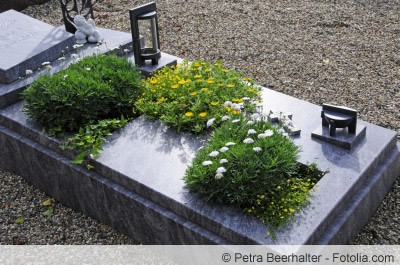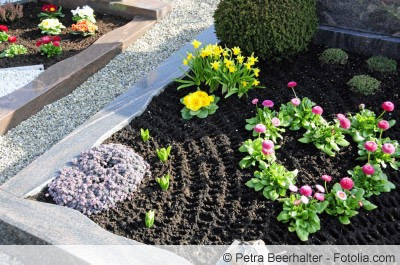

Table of contents
- barrow
- Cemetery Rules
- planning
- first planting
- planting time
- design, examples
- Low-maintenance design with small trees
- Structure with few easy-care perennials
- Seasonal plant selection
- spring
- Summer
- Autumn
- Conclusion
Depending on the location of the grave, it may be necessary to select a grave planting that is particularly easy to care for. It is not always possible for someone to drop by regularly for watering, weeding or pruning. Anyone who includes such considerations in the design of the grave and the initial planting will grow over years visit a tasteful, beautiful place of final rest for a loved one at any time can. The design of a low-maintenance grave must therefore be well planned. The limited space as well as the local location are other important factors for planning.
barrow
Immediately after the burial there is a burial mound. Only after about four to six months will this have sunk so far that the grave can finally be designed and planted. How long this takes in each individual case depends entirely on the weather conditions and the soil conditions. During this initial period you can put seasonal plants on it or simply leave the mound empty and wait for the soil to form a level surface with the surrounding area.
Cemetery Rules
In many cemeteries there are certain rules for the design of a grave. One would like to give the cemetery as a whole a calm and harmonious look. Regulations can range from the size of the tombstone to the planting for each season. Inquiring about this in advance with the cemetery administration can save a lot of extra work and trouble afterwards.
planning
If the burial site is ready for the first planting, the following factors must be taken into account when planning:
- Cemetery Regulations
- Tombstone and available space
- season
- Predilection for certain plants (deceased, relatives)
- Location (full sun, shady, semi-shady)
- soil conditions (moist, dry)
- maintenance of the plants
- irrigation possibility
first planting
When designing a low-maintenance grave, it is crucial to choose the right plants. After all, they will serve as permanent structure providers for years to come. In order for a grave to look well-groomed without all too frequent and intensive gardening, you should leave as little free floor space as possible. The less open space left, the less quickly the soil dries out. This also puts the weeds in their place. For these reasons, it is advisable, for example, to choose an evergreen ground cover for the design of the basic structure. The ground cover plants should be selected according to whether the location is shaded by trees or exposed to the blazing sun. In cemeteries, the graves are often shaded by old trees.
Suitable ground cover for shady locations are for example:
- fat man (Pachysandra terminalis)
- Ivy (Hedera helix)
- Cotoneaster (Cotoneaster dammeri)
- Ysander (Pachysandra terminalis)
- Hazel root (Asarum europaeum)
- Star Moss (Sagina subulata)

For sunny locations the following ground covers are suitable:
- Blue Periwinkle (Vinca minor)
- Medlar (Cotoneaster dammeri)
- Carpet juniper (Juniperus horizontalis)
- Ground cover roses
- Wild thyme (Thymus serpyllum)
- Andean cushion (Azorella trifurcata)
- Lesser Lady's Mantle (Alchemilla erythropoda)
- Creeping juniper (Juniperus horizontalis)
- Woolly Ziest (Stachys)
Tip:
Can one only rarely take care of the gravesite and is it also exposed to the sun all day long? A ground cover of beautiful pebbles as a base, along with sun-familiar potted plants combined, is an easy way to make a grave attractive and stylish even in the blazing sun design.
The following questions can also be helpful as a decision-making aid for easy-care initial planting:
- Can further care be taken over by relatives, and to what extent?
- Will grave maintenance be commissioned?
- Is an addition depending on the season (spring, summer and autumn planting) desired or is it even a requirement?
- How high is the budget for the planting or for the care of the grave?
Tip:
Even if you decide to tend the grave yourself, it can be helpful to consult a cemetery gardener before planting. He knows the nature of the soil on site and must have seen many plants come and go there.
planting time
If the time for the first planting falls in winter, you should wait until spring to plant. In the winter months, the grave is best covered with fir branches or brushwood. Flower bowls or arrangements can decorate the grave during this time. Covering the bare soil in the winter also ensures that the soil provides good breeding ground for the new plants in the spring.
Otherwise, depending on the choice of plants, you can actually start planting for the rest of the year. However, the best season for this is autumn. Especially for ground cover plants and hedge plants for subdivisions and borders or small trees.
design, examples
Here are some low-maintenance graveyard design ideas. The right proportions are particularly important in a very limited space. The height of the ground cover, the enclosing and dividing hedges and trees should ultimately harmonize with the size of the grave and the gravestone.
Low-maintenance design with small trees
Yew, thuja, boxwood or juniper are easy to keep in shape and are also extremely easy to care for. Placed next to the tombstone, they can form a calm background. If you like, you can cut them (or have them) into simple ball or cone shapes.
Dwarf pines, Japanese azaleas or Japanese holly make the grave look classy and tidy at any time of the year.
Structure with few easy-care perennials
You should not plant too many different varieties, especially in small areas, as this can quickly become restless and confusing. A nice combination for smaller burial sites is snow heather with cotoneaster and some purple bells in between. Depending on the size, the snow heather can be repeated in the front part. A low, robust bed rose with a long flowering period can refine the overall picture on the right or left. Suitable rose varieties are, for example, the small shrub roses:
- heather dream
- The Fairy
- summer wind
These roses can also be combined in a classic way, like in the garden with lavender. This results in a romantic, harmonious picture for most of the year. The maintenance effort is very low.
Tip:
If you want to plant ground cover roses, you should keep in mind that they can become quite overgrown over time and cover everything.
Seasonal plant selection

Some tips for choosing ground cover to give the grave a harmonious and at the same time easy-care structure have already been listed in the "First planting" section. Seasonal, easy-care and, above all, flowering plants can be used as a supplement.
spring
In spring, colorful early bloomers such as crocuses, hyacinths, daffodils and tulips can beautify the still dreary surroundings. Horned violets, pansies and forget-me-nots are particularly easy to care for and bloom tirelessly for many weeks.
Summer
In summer, it's all about picking out those summer bloomers that don't need to be watered every day. Begonias, geraniums, busy lizards and fuchsias survive dry periods better than petunias and daisies. It also depends on the location of the grave.
The Mandevilla (Dipladenia) is almost an insider tip and maybe not known to everyone. She is a colorful addition from the sun-kissed parts of the world. It blooms reliably and robustly all summer long into autumn. The Mandevilla can be perfectly combined with geraniums from the cranesbill family. Both have no problem with occasional dry periods.
Autumn
In October, the decorations for All Saints' Day and the preparation for winter begin. Small, hardy, undemanding aster and chrysanthemum varieties ensure a colorful autumnal bed. With their delicate white or pink colored flowers, cyclamen provide a nice contrast to evergreen ground covers. The small variety is more robust against cold. The Christmas roses are even nobler and more frost-resistant. But a vase with cut flowers can also enrich the overall wintry picture from time to time.
Conclusion
You have an uncomplicated basis with an easy-care grave planting of ground cover, small hedge plants that give shape or trees. There is also a large selection of easy-care plants for seasonal splashes of colour. If you can't deal with the care or planting of the grave at all, you can get offers for the annual care of a grave from the cemetery gardener. The easier the plants you choose to care for, the cheaper the grave maintenance fees will be.
 garden editorial
garden editorial I write about everything that interests me in my garden.
Learn more about grave design

18 grave plant ground covers for every season
Hardy ground covers are ideal for year-round grave care. In this way, the grave is decoratively designed at any time of the year without a great deal of maintenance. Because not only visually, but also in terms of weeds, which have little chance with many ground cover plants, the plants are ideal for a properly designed grave.

Grave planting in autumn and winter: 15 grave design tips
The right grave planting provides attractive accents during the cold season. The grave design is very extensive and makes use of a variety of different plants. In this guide you will find 15 tips that will bring you closer to grave planting.

Autumn planting in the cemetery: 10 ideas, tips and plants for the grave
Autumn planting in the cemetery is taken seriously by many. New plants are planted and leaves are removed. In some cases, autumnal or winter arrangements and wreaths are also placed on the grave as additional decoration. Our ideas and tips bring variety.

Grave planting in summer - ideas for cemetery planting
The grave planting in summer needs to be well thought out, since high heat and little time for watering quickly damage the plants and thus lead to an unsightly appearance. However, with these suggestions and ideas for planting in a cemetery, there is no need to do without blooming flowers and decorative combinations.

Make grave arrangements for Totensonntag yourself – DIY instructions
November is dedicated to the loving remembrance of the deceased. The traditional highlight is the last Sunday of the church year, with magnificently decorated graves. Relatives are increasingly choosing to make grave arrangements for Totensonntag themselves as part of active mourning work and to save costs. This DIY guide shows you how.

Grave plants for sunny and shady locations
The grave planting should radiate dignity and calm and be decorative. But it must also be suitable for the location and easy to care for, because daily watering would otherwise often be necessary, especially in summer - but hardly possible. Above all, the selection of grave plants for sunny and shady locations is therefore crucial.

